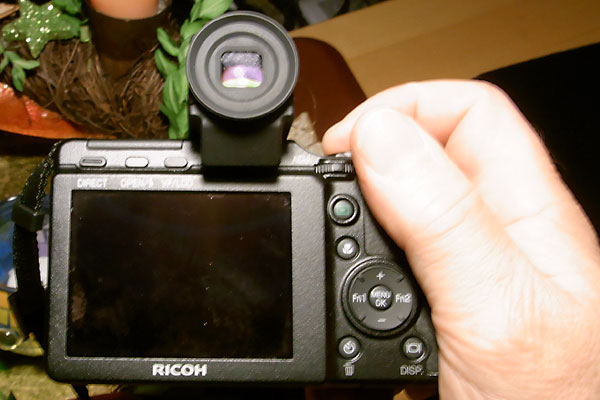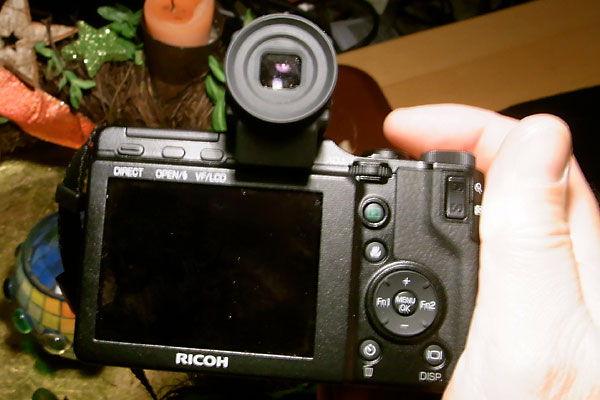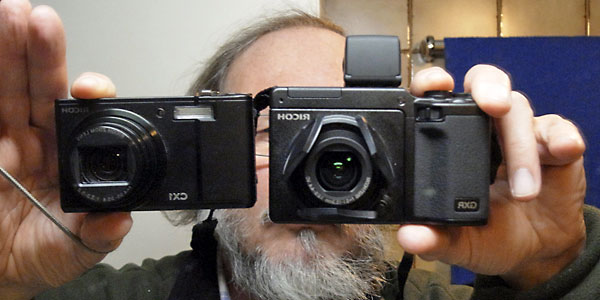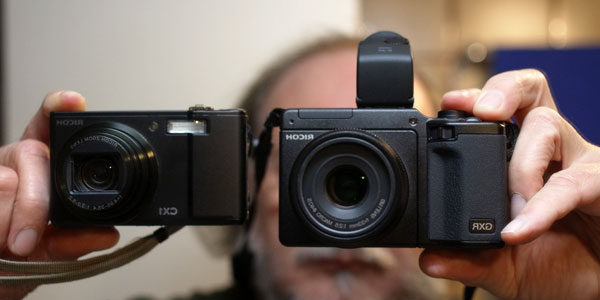Ricoh GXR: Initial Experiences
Look, Feel, and Weight - Pocketability? | LCD and Viewfinder | Menu System | Individual Settings for the Units | Autofocus and Manual Focus, Macro Mode | Overall Speed | Preliminary Conclusions
Archive
On this page, I collect my initial Ricoh GXR experiences that I had published on the Internet (before firmware update 1.17). Please not that the statements regarding AF speed are largely outdated, because (two) firmware updates improved AF speed.
Note: I collect further experiences on a separate page.
Look, Feel, and Weight - Pocketability?
The GXR looks definitely "professionally," not like a consumer camera - I presume that there will never be a pink version of the GXR... The GXR feels rather solid and quite a bit heavy, particularly when equipped with the A12-50 camera unit and the EVF-2 viewfinder.
I would not call the GXR a beauty, but in my opinion it is also not ugly; it reminds me somewhat of analog viewfinder cameras (but does not have an optical viewfinder...). It's easy to hold with the right hand (although it feels "heavy" and may strain your hand), but initially I had some problems with placing my right thumb - the camera back is rather crowded. In the meantime, I feel more comfortable with it.
 |
 |
Photos: Two attempts showing the back having my wife's CX1 in my left hand...
The GXR does not have a "GX300" feeling for me with S10 camera unit attached, though: it appears bigger, particularly higher, but as I sold my GX200 I can no longer compare them... With the A12-50 camera unit and the viewfinder attached, the GXR reminds me more of a small DSLR, which in some respects comes close to the truth. This is much more so with the M-mount expansion unit and an M-mount lens attached.
Now from "feelings" to data - at least the weight can be measured. Our scales tell us the following (which should be true to plus/minus 10 percent):
- GXR-S10, EVF-2, LC-2, battery, SD card, shoulder strap (the one that came in the box): 407g
- GXR-S10, LC-2, battery, SD card, shoulder strap (the one that came in the box): 381g *
- GXR-A12-50, EVF-2, lens cap, battery, SD card, shoulder strap (the one that came in the box): 515g
- CX1, battery, SD card, wrist strap (our own strap), for comparison: 204g
*) I did not have the protector for the flash hot shoe available. Also subtract the weight of the shoulder strap and add the weight of a wrist strap - should be around 350g.
Thus, the "GX300" comes at nearly exactly double the weight of the CX1. That's quite a lot!
There has been a lot of discussions regarding the pocketability of the GXR. This is, in my opinion, a decision that depends largely on personal preferences and habits:
- the size of your pockets
- how heavy a camera can be in a pocket - what do you find acceptable, and what not
- which pocket you are referring to (trouser, shirt, coat, ...)
As I never carried my GX200 with attached viewfinder in my pockets, I will not carry the GXR in my pockets either (exception: when wearing a coat). Thus, all in all, I would not call the GXR a "pocketable" camera. For my GX200, I used Ricoh's SC45 case connected to a strap around my neck. I will not buy a new case for the GXR and will just use the shoulder strap for carrying it. I own a larger bag for carrying further equipment when I think that I will need it. When wearing a coat, I can put the unused module into a coat pocket (as I did today). So, I will look like a typical tourist when using the GXR! However, that should not be an issue for me, because I do not have any plans for engaging in street photography...
 |
 |
Photos: Size comparisons between CX1 and the GXR with S10 camera unit (left) and A12-50 camera unit (right) (click images for larger versions)
LCD and Viewfinder
The LCD screen on the back of the camera offers a high resolution of nearly one million pixels (however, one pixel for each primary color, meaning that it's actually a VGA resolution). It seems to be the same screen as the one that is being used in the CX series, and I knew it already from my wife's CX1. However, coming from an SLR tradition and being far-sighted, I always preferred electronic viewfinders over LCD screens. Moreover, pressing the camera against your forehead stabilizes the camera, thus avoiding camera shake. In addition, I prefer to have a preview of the exposure in the viewfinder and also to see the result immediately after the photo has been taken. When using my DSLR, I always forgot to check the exposure on the LCD screen (which was somewhat cumbersome for me, because I had to put glasses on, etc.). I am well aware that there are different opinions about this topic. Street photography, for example, is better done with the LCD screen - but I myself would never buy a camera that offers only an LCD-screen on the back.
Therefore, the interesting question for me was (and I was asked this already in a forum): How good is the electronic viewfinder? Once again, I cannot offer an "objective" answer. I can only say: It is much better than all the EVFs that I have used in the past, and I like it a lot. Here are a few characteristics of the EVF-2:
- Pixels are nearly invisible (should be even better in the new Olympus Pen2, Panasonic, and Sony viewfinders...)
- It is possible to focus manually with the EVF - at least under normal conditions - although not easy
- There is some grain when it is getting dark, but in an optical viewfinder you may see nothing
- Speed regarding camera moves and moving objects seems to be OK - up to now I did not find any noticeable or annoying delays
- Visibility in bright light (updated in May 2010): Not good, as long I do not use my hand to shelter my eye from the sun light (valid for spring to autumn...). A better eye cup would help a lot...
- The image is not as large as in a DSLR, but I have been told that some entry-level DSLRs have lousy optical viewfinders (my Sony A700 had a very good one!)
When I tested the GXR in macro mode and took close-up photos, I found that the EVF view was somewhat "wobbly" - I can provide no better description for this effect here. As I could not hold the camera steady, the objects were moving around in the viewfinder and showed this "wobbling" effect - probably due to some delays when the camera was refreshing the display.
All in all, the EVF is still far away from a good optical viewfinder, but it also has advantages such as exposure preview or the ability to display grid lines (but this is a general advantage of EVFs, not one specific to Ricoh's EVF-2). So, should you buy the EVF-2? If you worked primarily or exclusively with the LCD screen in the past, I would say no. You will have a lighter and more compact camera without the EVF-2 and you will also save some money. For all others, I would say yes.
Addendum: In the meantime (as of end of 2011), other manufacturers have built better viewfinders into their cameras, particularly Sony (Nex5N, Nex7), and GXR users are eagerly awaiting that Ricoh will use them as well.
Menu System
The GXR menu system is similar to other Ricoh cameras and seems to come closest to the CX series (because of the same screen resolution). I had some initial issues with setting the correct image size, because I did not understand the captions on the screen, but now I know that I have to use "L"! Some testers called the CX menu system"dull" because it does not have any funny icons. I am glad that there are none!
I like the direct menu - my Sony A700 had a similar menu - but I still forget to use it: It's too new for me (on a Ricoh)! There is another advantage of the direct menu: I can see it without glasses on the LCD screen.
Individual Settings for the Units
I always wondered how different settings for the different camera units can be realized, which is, of course, desirable, because the units are more or less different cameras and, therefore require different settings. And nobody is willing to reset settings after changing a unit. Up to mid-February 2010, not many many users seem to have bothered - I read just one post, in which the user wrote that this problem was the reason why he did not change units...
I always had the suspicion that the "Start Settings Readout" would be involved here, but I never tried that. In mid February 2010, there was a discussion at dpreview about this topic (originating from a thread about a review at Steve's Digicams, and therefore somewhat hidden...). There Ardexx, in a reply to Andrew, pointed to these settings, but it looks as if he has not been successful in using this feature yet.
Anyway, I did a quick check regarding the "Start Settings Readout" and can confirm that at least a number of settings are stored when the settings readout at startup is set to "camera unit." First, I had the S10 attached, when I did the menu setting for startup readout. Then I changed a number of settings, particularly in the adjust menu, to some arbitrary values. Then I switched to the A12-50, which showed a lost of "funny" settings: Language changed from German to English, different items in adjust menu etc. I changed that back again but to settings that were different from the current S10 settings. Then, I switched camera units again. The S10 had kept its new settings. I switched another time, set the A12-50 to the values that I wanted it to have, and then again for the S10 and set also values that I want to use. Seems to "work as expected."
Then, I did another check regarding the MY settings. According to this test, the MY settings are stored individually for both units if you set the start up readout to "camera unit." You can also save modes like A, S, or P in those settings. Thus, in this case, too, the system "works as expected."
Autofocus and Manual Focus, Macro Mode (Before Firmware Update 1.17)
When testing both camera units. the S10 and the A12-50, I found that the S10 is slightly faster than the A12-50 when focusing automatically. It takes two-and-a-half goes before it locks in and makes a high-pitched noise when focusing. The A12-50 sounds nicer, but the AF is somewhat slower, restarts sometimes, and on rare occasions misses the target completely. Professional testers will probably provide us with exact timing data... As expected, macro AF is slower than normal focus for both units. The S10 seems to focus faster than my GX200 in macro mode (the CX1 is definitely faster). The A12-50 can be very slow in macro mode, depending on the subject.
Manual focus seems to be a good idea here, as the EVF allows for manual focusing, depending on subject, lighting, etc.. However, I found that the "by wire" manual focusing is not as direct as a mechanical connection - sometimes nothing seems to happen, sometimes the focus seems to jump. More practice is definitely needed from my side...
When manually focusing in macro mode with the A12-50, there are two scales: one between infinity and 30cm, another one between 30cm and 7cm. The scales switch automatically, when you turn the focus ring. In the range between 30cm and 7cm, focusing manually can be painfully slow, particularly between 7cm, the minimum distance, and 10cm.
For the S10, more or less the same applies. However, the close-up scale varies between 30cm and 1cm. Depending on the focal length, you cannot go as far as 1cm (only between 24mm and 50mm; at 72mm you can go slightly below 3cm).
By the way, I was asked whether macro mode focuses up to infinity - it does!
Overall Speed (Before Firmware Update 1.17)
I was asked regarding complaints about the review and zoom speed. While there is a short, noticeable delay before an image appears on the screen, it's fast enough for me. I also do not have any complaints regarding zooming and panning speeds.
Shooting speed has still to be investigated. As it depends on AF speed, there are some delays due to slow auto focus (particularly in macro mode and when restarting after a miss). As already mentioned above, the A12-50 seems to be slower than the S10.
In the meantime, I tested the speed of continuous shooting and found a speed of about 3 images per second for auto as well as manual focus - that is exactly what the specs promise.
Preliminary Conclusions (Before Firmware Update 1.17)
I just bought the GXR and some equipment for a lot of money. Overall, I am quite satisfied with it (to avoid cognitive dissonance...) and will, of course, keep it - hopefully - for a longer period of time. In my opinion, Ricoh could have done better regarding the AF speed and accuracy, particularly for the A12-50, which from time to time misses the target. There are also some initial issues that are typical for new cameras. Ricoh should have eliminated these issues from the beginning, as the conditions under which they occur are not that esoteric. But, we have become used to being users of banana software and products, and hopefully these issues can be ironed out in an upcoming firmware update.
I am less confident regarding the AF speed issues. I know that Olympus struggles with contrast AF, too, but Panasonic seems to do much better - so why cannot Ricoh do better was well? I hope that future firmware updates will also provide some improvements in this area, even though I am skeptical in this respect.
All in all, the Ricoh GXR is definitely an adventure and demanding. It has to be mastered - but that's what makes it interesting and attractive for me.
| 19.11.2020 |